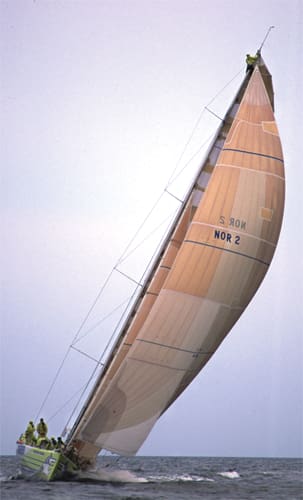Dacron: Dacron is the generic name given to the DuPont yarn made of polyethylene terephthalate (PET), and is a popular choice for cruising sails because of its overall lifespan and reasonable cost. It is susceptible to stretching over time, is UV resistant and relatively inexpensive. Also, the average boater can patch a tear themselves given the right tool kit and a little time. Dacron is related closely to polyester, and when spun into yards of fabric, is coated in a resin that both tightens the weave (adding to strength) and shields against UV rays. It is woven in such a way that the fill fibers (running across the width of the fabric) are greater in number than the warp (lengthwise) fibers. Richard Hallett, of Hallett Canvas & Sails, advises that, “Dacron may lose its designed shape more quickly than other materials because it isn’t as strong in the warp direction, but overall it will last much longer.”
Spectra: Spectra is similar to Dacron in that it is a thermoplastic polyethylene fiber, but Spectra is classified as an ultra high molecular weight polyethylene. Spectra is more UV resistant due to higher diameter yarns. Due to its chemical makeup and greater UV resistance, Spectra has more strength against breaking and flexing than Dacron. One downside, though, is that under continual stress it begins to “creep,” or permanently stretch out of shape. It is also about three-times more expensive than Dacron. Spectra is one of the few woven materials that possesses greater warp strength — generally a characteristic of laminated sailcloth. Given its warp strength, Spectra works best if cut and seamed into radial patterns — generally triangular panels that follow the natural load paths generated from the corners of the sail.
Laminates: Eric Baldwin, of North Sails, described the topical advantages to laminate sailcloth; “Its strength-to-weight ratio makes it a more attractive choice. And, for the same size sail as a Dacron (weave), it holds its shape better.” Baldwin also described poor life expectancy as a consistent downfall of laminate cloth. “You could try to patch a tear and it may hold up, but once it starts to delaminate it’s pretty much unusable. Also, since laminates don’t breathe, mildew will start to form… if it’s been under a cover for a period of time.” But, according to Win Fowler of Maine Sailing Partners, that side effect is not structurally damaging, merely “cosmetically unfortunate.”
Sailcloth laminates by definition are a varied combination of these materials: fabrics (“taffeta”); mylar films; and yarn strands (“scrims”). A common example would be a film-scrim-film combination: A given structural fiber — such as Kevlar, Twaron, or even carbon — is laid between two layers of film. The fibers within the film might be laid at precise angles for a custom fit, and the overall material can be designed to be stronger in either the warp or fill direction.
Mylar: Mylar is a DuPont PET product. It is formed into thin plastic sheets that are used to shield fibers in the lamination process. Mylar films add tensile strength to the cloth. When combined with more advanced yarns, it helps create some of the best performing sails available.
Kevlar: Kevlar is the generic name for yet another DuPont synthetic polymer product. It is a light-weight, high-strength fiber classified as an aramid that is perhaps most popular for use in bulletproof vests. Kevlar has been registered as five-times stronger than steel relative to its weight. Kevlar is created from a unique polymer that has sulfuric acid applied to it during the spinning process in order to keep it soluble. In sails, Kevlar is often laid between laminate films as a scrim to offer a strong, flexible structure to the design. The downside to Kevlar, and other cloths like it in the aramid family, is poor UV resistance. It is twice as susceptible to sunlight as PET products and is less resistant to wear from folding and flexing.
Twaron: Twaron is a para-aramid product created and distributed by the recently expanded company Teijin Aramid, of the Netherlands. The name for the product has changed a handful of times since the 1960s, when it was originally called Fiber X. Depending on the film it is combined with, the UV resistance, overall tensile worth, and resistance to abrasion will vary. As with many advanced polymer-to-fiber processes, what starts as a liquid chemical is spun into solid material. That fiber can be woven into sheets or kept as yarn. Twaron is structurally similar to Kevlar and offers a very high strength-to-weight ratio.
Carbon fiber: Carbon atoms are crystalized and combined in a fiber, thousands of which are spun into a yarn strand. That yarn may be woven into sheets of carbon fiber, but often is used in sailcloth as one element of a greater composite. Carbon fiber’s rigidity and strong resistance to UV damage make it an excellent piece to a laminated composite sail, but it does not fair well on its own — carbon itself is too brittle to create an efficient film-scrim-film laminate.
Zylon: Zylon is another advanced polymer commonly found aboard sailing vessels. Due to its advanced design, construction and cost, though, those vessels are often racers. It is incredibly light and incredibly stiff, but unlike many of the previous materials, is notably less durable on its own. Visible light, let alone UV, damages the fiber; and it is also subject to rapid degeneration from salt water and any chafing. For that reason it is usually shielded by some form of resin, which is heat-applied to the particular product being fashioned. Zylon can be utilized as sail material, but is used mostly in standing rigging.

